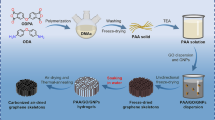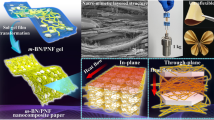Abstract
This study found out a heat treatment condition to improve the electrical conductivity of polyurethane (PU) nanoweb treated with non-oxidized graphene (nOG) ink. Electrical conductivity was imparted to the PU nanoweb (Pardam, s.r.o., Czech Republic) by a dip-coating process utilizing 1 wt% of nOG ink. To enhance the electrical conductivity, post heat treatment was conducted. The first specimen was completely dried at room temperature (20 °C) for 24 hours (Specimen GU), and the rest of the specimens were treated at 40 °C, 60 °C, 80 °C, and 100 °C for 1 hour (Specimen G40, G60, G80, and G100). To confirm the microstructure of the specimens, a FE-SEM (Field emission scanning electron microscopy) was utilized. The linear electrical resistance was evaluated using a Digital multimeter. Also, the thickness and weight of the specimens were measured by Cross section polisher and Analytical balance respectively. After that, the chemical structures were inspected using a FT-IR (Fourier transform infrared spectroscopy). As a result, when the heat treatment temperature was higher, the specimens were well immersed and more nOG ink was covered onto the surface of the treated specimens. Also, the electrical resistance of the specimens decreased in accordance with increased heat treatment temperature. The thickness and add-on of the specimens increased as the heat treatment temperature increased. The changes of band position of C=O, C-O-C, -NH- bending were observed by FT-IR analysis. Therefore, this study demonstrated that the heat treatment temperature played a significant role in the improvement of electrical conductivity, and the nOG/PU nanoweb had the most enhanced electrical conductivity when treated at 100 °C.
Similar content being viewed by others
References
R. Paradiso and D. De Rossi, Proceedings of the 2008 30th Annual International Conference of the IEEE Engineering in Medicine and Biology Society, 3629, 2008.
E. Lee and G. Cho, Text. Res. J., 89, 2938 (2019).
M. Ghahremani Honarvar and M. Latifi, J. Text. Inst., 108, 631 (2017).
I. Kim, E. Lee, E. Jang, and G. Cho, Text. Res. J., 88, 1215 (2018).
E. Lee, I. Kim, H. Liu, and G. Cho, Fiber. Polym., 18, 1749 (2017).
L. Persano, A. Camposeo, C. Tekmen, and D. Pisignano, Macromol. Mater. Eng., 298, 504 (2013).
F. Cengiz and O. Jirsak, Fiber. Polym., 10, 177 (2009).
D. Kimmer, P. Slobodian, D. Petráš, M. Zatloukal, R. Olejník, and P. Sáha, J. Appl. Polym. Sci., 111, 2711 (2009).
X. Zhang and Y. Lu, Polym. Rev., 54, 677 (2014).
Y. Ahn, S. Yoon, and K. Kim, Text. Sci. Eng., 49, 47 (2012).
E. Lee and G. Cho, Smart Mater. Struct., 28, 045004 (2019).
I. Kim and G. Cho, Smart Mater. Struct., 27, 075006 (2018).
H. Ahn, C. Park, and S. Chung, Text. Res. J., 81, 1438 (2011).
J. Sung, H. Kim, H. Jin, H. Choi, and I. Chin, Macromolecules, 37, 9899 (2004).
H. Kim, H. Jin, S. Myung, M. Kang, and I. Chin, Macromol. Rapid Commun., 27, 146 (2006).
A. Laforgue and L. Robitaille, Synth. Met., 158, 577 (2008).
V. Gupta and T. Saleh, Environ. Sci. Pollut. Res., 20, 2828 (2013).
S. Stankovich, D. Dikin, G. Dommett, K. Kohlhaas, E. Zimney, E. Stach, R. Piner, S. Nguyen, and R. Ruoff, Nature, 442, 282 (2006).
G. Eda, G. Fanchini, and M. Chhowalla, Nat. Nanotechnol., 3, 270 (2008).
C. Wu, T. Kim, F. Li, and T. Guo, ACS Nano, 10, 6449 (2016).
E. Jang and G. Cho, Fashion Text. Res. J., 20, 101 (2018).
E. Jang, H. Liu, and G. Cho, Text. Res. J., 89, 4980 (2019).
D. Brownson, D. Kampouris, and C. Banks, J. Power Sources, 196, 4873 (2011).
Q. Wu, C. Liu, L. Lei, X. Yan, B. Wang, X. Liu, and Y. Lv, Transplant Proc., 42, 1963 (2010).
K. Zhang, L. Zhang, X. Zhao, and J. Wu, Chem. Mater., 22, 1392 (2010).
S. Stankovich, D. Dikin, R. Piner, K. Kohlhaas, A. Kleinhammes, Y. Jia, Y. Wu, S. Nguyen, and R. Ruoff, Carbon, 45, 1558 (2007).
J. Choi, W. Kim, E. Lee, and G. Cho, Fiber. Polym., 21, 978 (2020).
H. Shi, C. Liu, Q. Jiang, and J. Xu, Adv. Electron. Mater., 1, 1500017 (2015).
B. Cipriano, A. Kota, A. Gershon, C. Laskowski, T. Kashiwagi, H. Bruck, and S. Raghavan, Polymer, 49, 4846 (2008).
L. Song, F. Khoerunnisa, W. Gao, W. Dou, T. Hayashi, K. Kaneko, M. Endo, and P. Ajayan, Carbon, 52, 608 (2013).
G. Trovati, E. Sanches, S. Neto, Y. Mascarenhas, and G. Chierice, J. Appl. Polym. Sci., 115, 263 (2010).
Acknowledgments
This research was supported by the Basic Science Research Program through the National Research Foundation of Korea (NRF) funded by the Ministry of Education, Science and Technology (No. NRF-2016R1A2B4014668, NRF-2019R1F1A1060955) and the Brain Korea 21 Plus Project of Dept. of Clothing and Textiles, Yonsei University in 2019.
Author information
Authors and Affiliations
Corresponding author
Rights and permissions
About this article
Cite this article
Kim, W., Lee, E., Choi, J. et al. Improved Electrical Conductivity of Polyurethane Nanoweb Coated with Graphene Ink through Heat Treatment. Fibers Polym 21, 1195–1199 (2020). https://doi.org/10.1007/s12221-020-9912-x
Received:
Revised:
Accepted:
Published:
Issue Date:
DOI: https://doi.org/10.1007/s12221-020-9912-x




